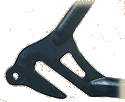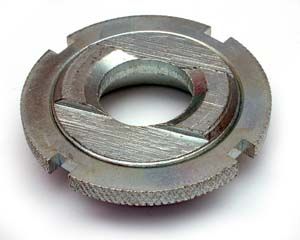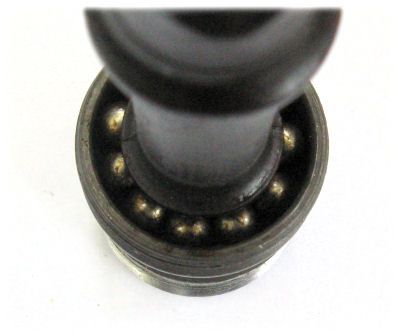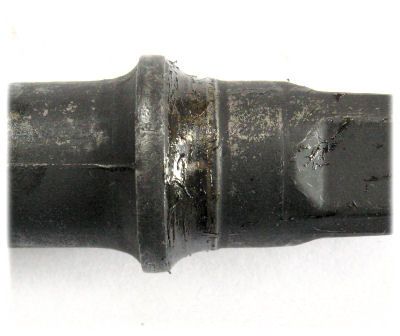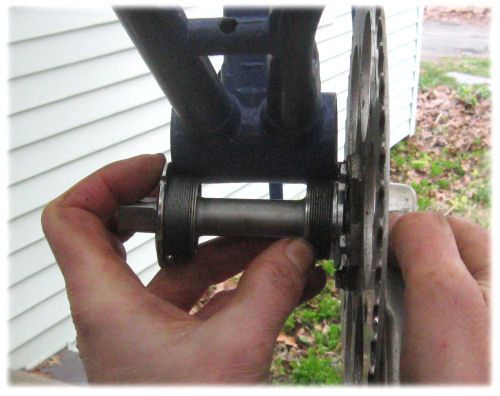Besonderheiten bei Gewinden/Austauschbarkeit bei älteren Raleigh Fahrrädern: Unterschied zwischen den Versionen
(→Kurbeln mit Splintbefestigung aufrüsten: Bilder hinzugefügt) |
(→Neue Welle, alte Lagerschalen: Übersetzungsanfang) |
||
| Zeile 53: | Zeile 53: | ||
====Neue Welle, alte Lagerschalen==== | ====Neue Welle, alte Lagerschalen==== | ||
Die bei weitem günstigste Methode ist das Beibehalten des originalen 26 TPI Gewindes und der passenden Lagerschalen und eine neue Welle zu verbauen, die zu Kurbeln ohne Splintbefestigung passt. Der Innendurchmesser der Lagerschalen ist jedoch minimal kleiner als bei anderen Marken, so dass unglücklicherweise nicht alle Wellen passen werden. Man kann jedoch die Standard 1/4 Zoll [[Lagerkugel]]n gegen 6 mm (15/64 Zoll) Lagerkugeln tauschen. Nicht alle Fahrradläden haben diese Größen am Lager. Im Internet wird man jedoch schnell fündig. | |||
Du solltest die Passung der Innenlagerwelle, der Lagerkugeln und Lagerschalen prüfen, bevor Du alles montierst. Falls die Lagerkugelspur zu niedrig auf der Welle verläuft, werden die Lagerkugeln schnell verschleißen. | |||
Gib ein wenig Montagefett in die Lagerschale, baue alle Teile zusammen (wie im Bild unten) und rotiere die Welle. Nimm die Welle heraus und betrachte das Ergebnis. | |||
[[Datei:Bearings in cup.JPG|center|Welle in Lager]] | [[Datei:Bearings in cup.JPG|center|Welle in Lager]] | ||
Im nächsten Bild sieht man, dass die Legrkugelspuren zu niedrig verlaufen. So ist es zumeist bei [[JIS]] Wellen in Raliegh Lagern. Tatsächlich laufen die Kugeln auf dem kleinen Vorsprung auf der Unterseite des Lagersitzes der Welle. Das drückt die Lagerschale nach außen und kann trügerisch nach einer guten Passung in einem breiten Raleigh Twenty Innenlager aussehen. | |||
[[Datei:Bb-axle low track small.JPG|center|Lagerspuren zu niedrig]] | [[Datei:Bb-axle low track small.JPG|center|Lagerspuren zu niedrig]] | ||
Im nächsten Bild sieht man den korrekten Sitz, wenn man 6 mm ´Lagerkugeln und eine JIS Welle benutzt. Der Lagerkugelspuren sind mittig auf dem Lagersitz der Welle gut zu erkennen. | |||
[[Datei:Bb-axle correct track.JPG|center|Lagerspuren in Ordnung]] | [[Datei:Bb-axle correct track.JPG|center|Lagerspuren in Ordnung]] | ||
Raleigh | Raleigh Lagerschalen werden nicht länger hergestellt, sind jedoch extrem haltbar. Gebrauchte Schalen in guter Verfassung können oft aus entsorgten Rahmen gerettet werden. | ||
Raleigh bottom bracket shells are wider than the standard 68 mm width of B.S.C./ISO bottom brackets, commonly anywhere from 71 mm to 76 mm. As a result, you'll need a longer-than-normal spindle. Japanese JIS-standard spindles are generally designated by a simple code consisting of a single digit followed by one or more letters. | Raleigh bottom bracket shells are wider than the standard 68 mm width of B.S.C./ISO bottom brackets, commonly anywhere from 71 mm to 76 mm. As a result, you'll need a longer-than-normal spindle. Japanese JIS-standard spindles are generally designated by a simple code consisting of a single digit followed by one or more letters. | ||
Version vom 12. Juli 2017, 07:46 Uhr
Das Unternehmen Raleigh ist eines der ältesten existierenden. Ihr Geschichte geht bis in das frühe 20. Jahrhundert zurück. Damals waren Gewindegrößen von Schrauben und andere Größen nicht so weit standardisiert wie sie es heute sind. So entwickelte jeder Hersteller seinen eigenen proprietären "Standard".
Über die Jahrzehnte führt das zu viel Verwirrungen und Schwierigkeiten, die dazu führten, dass man sich um industrieweite (oder zumindest nationale) Standards bemühte.
Um die Jahrhundertwende zum 20. Jahrhundert wurde die British Cycle Engineer's Institute (CEI) in Großbritannien gegründet, die sich um standardisierte Dimension kümmern sollte. Diese CEI Standards wurden bis nach dem zweiten Weltkrieg beibehalten. Danach wurden sie überarbeitet und wurden dann als BSC (British Standard Cycle) bekannt. Diese Standards bildeten die Grundlage für die ISO Standards ab den 1980er Jahren.
Zu dieser Übergangszeit nach dem zweiten Weltkrieg waren Raleigh so etwas wie das Microsoft der Fahrradindustrie und sah nicht ein, sich an die BSC Standards zu halten. Bis in die 1990er Jahre hinein wurden Raleigh Fahrräder aus der Produktion der riesigen Nottinghamer Fabriken nach den proprietären Raleigh-Standards hergestellt. Da Raleigh ungefähr jedes Einzelteil seiner Fahrräder selbst herstellte, gab es keine zwingenden Gründe für Raleigh, sich an die Standards anderer Hersteller zu halten. Da sollte man nicht zu streng sein mit Raleigh. Eine Umstellung wäre sehr kostspielig geworden und die Anteilseigner wären eine ganze Zeit leer ausgegangen.
Der Hauptunterschied besteht in den Gewinden von Tretlager und Steuersatz, die eine Gewindesteigung von 24 TPI nach BSC Standard und 26 TPI nach Raleigh Standard hatten.
Wie man ein Raleigh von anderen Marken unterscheidet
Der einfachste Weg, ein Raleigh Fahrrad zu identifizieren, ist ein Blick auf die hinteren Ausfallenden. Fast alle Raleigh Modelle haben die Öse für das Schutzblech direkt hinter der Achse statt darüber platziert. Das trifft allerdings nicht auf Roadster Modelle zu, die weder Ausfallenden noch Schutzblechösen haben.
Die meisten Raleighs haben einen Sattelstützendurchmeser von 1 Zoll (25,4 mm), während andere Fahrräder aus britischer Produktion normalerweise 1 1/16 Zoll (27,0 mm) Sattelstützenmaß haben.
Manche sportlicheren Modelle hatten konventionelle Ausfallenden. Diese lassen sich jedoch anhand des Raleigh Steuersatzes und Innenlager Lagerschalen unterscheiden.
Die Breite des Tretlagergehäuses ist auch ein Unterscheidungsmerkmal. Standardmaß für britische Innenlager (mit 24 TPI Gewindesteigung ist die Breite von 68 mm. Raleigh 26 TIP Tretlagergehäuse sind im allgemeinen 71 oder 76 mm breit.
Kurbeln mit Splintbefestigung (Raleigh 26 TPI Gewinde)
In späteren Jahren hatten Raleigh Modelle, die am Standort Carlton gebaut wurden, wie das International, Professional, Competition, Grand Sport und andere Modelle BSC Gewinde. Damit zogen sie mit Modellen aus Asien und den USA gleich. Diese Modelle erkennt man an den Kurbeln ohne Splintbefestigung.
Im Allgemeinen kann man sagen, dass Raleigh Modelle, die Kurbeln mit Splintbefestigung hatten, Gewinde mit 26 TPI an Tretlager und Steuersatz hatten. Das waren auch alle Modelle, die in der Nottinghamer Fabrik gebaut wurden und mit Rücktrittbremsen oder Nabenschaltungsnaben ausgestattet waren. Dazu gehörten auch preiswertere Modelle wie Kettenschaltung wie das Super Course, das aus nicht konifiziertem Reynolds 531 Rahmenrohren hergestellt war. Obwohl der Gewindedurchmesser exakt dem der BSC Gewinde entspricht, macht die Unterschiedliche Gewindesteigung die Bauteile nicht austauschbar. Im Verlauf des Artikels werden Maßnahmen erläutert, wie man um das Problem lösen kann.
Aufrüsten oder Restaurieren?
Bei älteren Fahrrädern fragt man sich oft, ob man sie der Nachwelt möglichst im Originalzustand erhalten soll oder ob es sich lohnt, sie für den täglichen Gebrauch zu modernisieren. Die Antwort auf diese Entscheidungsfrage lääst sich oft anhand von Alter, Zustand und Seltenheitswert beantworten.
Raleighs aus Nottingham wurden in großer Stückzahl gefertigt und ihren Qualität war so hoch, dass es immer noch sehr viele auf der Stra0ße gibt. Daher werden die meisten wohl nicht als "selten" gewertet.
Sehr wenige englische Fahrräder wurden vor dem zweiten Weltkrieg in die USA (oder auch Kontinentaleuropa) importiert. Daher sind sie im Straßenbild eher selten. Sheldon Brown bewertet daher alle Räder ab den 1960er Jahren als Freiwild, die Fahrräder aus den 1950ern als grenzwertig (Es gibt eine separate Seite, mit der man das Alter seines Raleighs schätzen kann).
Ein guter Kandidat für eine Restauration sollte mindestens grundlegend vollständig und mehr oder weniger rostfrei sein.
- Beachte
Natürlich ist diese Einschätzung etwas schwammig und wird sich mit der Zeit verändern. Das hängt davon ab, inwiefern diese Fahrräder seltener werden. Sheldon Brown gibt als Beispiel seinen Vater an, der an Model T Fords herumbastelte. Diese waren eher Wegwerfautos, die es in Massen gab und billig waren. Es war ein gängiges Hobby sie zu frisieren und zu seiner zeit recht sinnvoll. Heutzutage ist ein Model T im Originalzustand quasi unbezahlbar.
Raleigh Innenlager
Raleigh Innenlager Lagerschalen haben erhöhte Kanten, auf die ein 5/8 Zoll (bzw. 16 mm) Maulschlüssel passt. Das beste Werkzeug für diese Schalen ist das Park Tool HCW-11. Es gibt einige Artikel, die sich mit der Wartung von Kurbeln mit Splintbefestigung auseinandersetzen.
- Kurbeln mit Splintbefestigung
- Werkzeuge für Kurbeln mit Splintbefestigung
- Werkzeuge für Innenenlager Lagerschalen
- Einstellen des Lagerspiels bei Innenlagern
Kurbeln mit Splintbefestigung aufrüsten
Es gibt drei Methoden, ein Raleigh aus Nottinghamer Produktion zu Kurbeln ohne Splintbefestigung aufzurüsten.
Neue Welle, alte Lagerschalen
Die bei weitem günstigste Methode ist das Beibehalten des originalen 26 TPI Gewindes und der passenden Lagerschalen und eine neue Welle zu verbauen, die zu Kurbeln ohne Splintbefestigung passt. Der Innendurchmesser der Lagerschalen ist jedoch minimal kleiner als bei anderen Marken, so dass unglücklicherweise nicht alle Wellen passen werden. Man kann jedoch die Standard 1/4 Zoll Lagerkugeln gegen 6 mm (15/64 Zoll) Lagerkugeln tauschen. Nicht alle Fahrradläden haben diese Größen am Lager. Im Internet wird man jedoch schnell fündig.
Du solltest die Passung der Innenlagerwelle, der Lagerkugeln und Lagerschalen prüfen, bevor Du alles montierst. Falls die Lagerkugelspur zu niedrig auf der Welle verläuft, werden die Lagerkugeln schnell verschleißen.
Gib ein wenig Montagefett in die Lagerschale, baue alle Teile zusammen (wie im Bild unten) und rotiere die Welle. Nimm die Welle heraus und betrachte das Ergebnis.
Im nächsten Bild sieht man, dass die Legrkugelspuren zu niedrig verlaufen. So ist es zumeist bei JIS Wellen in Raliegh Lagern. Tatsächlich laufen die Kugeln auf dem kleinen Vorsprung auf der Unterseite des Lagersitzes der Welle. Das drückt die Lagerschale nach außen und kann trügerisch nach einer guten Passung in einem breiten Raleigh Twenty Innenlager aussehen.
Im nächsten Bild sieht man den korrekten Sitz, wenn man 6 mm ´Lagerkugeln und eine JIS Welle benutzt. Der Lagerkugelspuren sind mittig auf dem Lagersitz der Welle gut zu erkennen.
Raleigh Lagerschalen werden nicht länger hergestellt, sind jedoch extrem haltbar. Gebrauchte Schalen in guter Verfassung können oft aus entsorgten Rahmen gerettet werden.
Raleigh bottom bracket shells are wider than the standard 68 mm width of B.S.C./ISO bottom brackets, commonly anywhere from 71 mm to 76 mm. As a result, you'll need a longer-than-normal spindle. Japanese JIS-standard spindles are generally designated by a simple code consisting of a single digit followed by one or more letters.
- If the digit is "3" the spindle is made for a typical B.S.C./ISO 68 mm shell, and won't work in your Raleigh...the adjustable cup will sink in too far, so you won't be able to use the lockring.
- If the digit is "5" the spindle is made for in Italian-sized 70 mm shell, and may work in your Raleigh if it has a 71 mm shell -- but check whether this is due to a low bearing track.
- If the digit is "7" the spindle is made for an "oversized" 73 mm mountain bike bottom bracket. This will generally work in most Raleigh BBs but be too short for the 76 mm bottom bracket of the Raleigh Twenty. It may be a bit long in a 71 mm bottom bracket.
You may check whether the assembly is wide enough by holding it up next to the bottom bracket. The combination that seems to work best is a 7 series spindle with 6 mm bearing balls, in a 71 mm bottom bracket. You could also install a crank loosely to run a quick check on the chainline.
Just getting a spindle to fit into the frame is a start, but you may still have problems due to the overall length of the spindle. Older cranks used longer spindles than newer, "low profile" cranks. JIS axles are mostly available in longer overall lengths, which are likely to give poor chainline with newer cranks, though they will work. If you are spreading the rear dropouts of a frame to use a wider hub, you may want to increase the chainline anyway.
See my article on Bottom Bracket Sizes for information on spindle lengths for different cranks.
Patronenlager
Modern cartridge bottom brackets are much easier to install than the old-style cup-and-cone design. There are three possibilities for running a cartridge bottom bracket in a Raleigh 26 TPI shell:
Phil Wood
Phil Wood bottom brackets are sold separately from the mounting rings that screw into the frame. Phil Wood is the only manufacturer still supporting 26 TPI bottom bracket threading. The quality is superb, there's nothing better. Phil Wood bottom brackets are available in a great variety of spindle lengths, too. The bad news is that Phil Wood bottom brackets are among the very most expensive available.
Phil Wood retaining rings don't have any shoulders, so they can be screwed all the way into the shell, even recessed below the edge of the shell. This greatly reduces problems due to the wider shell width, and allows chainline adjustment by several mm.
Stock Phil Wood bottom-bracket cartridges for a 68 to 73-mm bottom-bracket shell are listed on the Phil Wood Web site. They will work with a 71 mm Raleigh bottom bracket. With a 76 mm bottom-bracket shell there is a risk that the mounting rings will run up onto the end of the threads inside the bottom-bracket shell and bind. Phil Wood has in the past made longer cartridges, though as of this writing only a few remain in stock.
Before installing, thread the mounting rings into the bottom bracket shell and measure to make sure that they thread in freely far enough to mate properly with the ends of the cartridge. There is more detail on installation in Raleigh Twentys on the Raleigh Twenty page, and on measurement for a Phil Wood bottom bracket on the cartridge bottom-bracket page.
The Phil Wood bottom-bracket spindle is press-fit into the bearings, and the chainline can be readjusted by realigning the spindle. Shimano UN72 With Phil Wood Rings
It happens that Shimano UN72 bottom brackets can also be used with Phil Wood retaining rings. The UN72 model is the only Shimano series you can use this way, because the other Shimano models have the right side threads machined into the cartridge body. The UN72 is even narrower than the Phil Wood 68-73 mm cartridge, and so it is not usable with a 76 mm bottom-bracket shell.
Unfortunately, for the 2003 model year, Shimano replaced the UN72 bottom bracket with the revised UN73 design. The UN73 is a fine bottom bracket, but it does not have a removable mounting ring on the right side. The threads are part of the shell, as with the other Shimano cartridges, so the UN73 will not work with Phil Wood rings. Velo Orange Threadless
Velo Orange makes a bottom bracket that clamps into the bottom-bracket shell with internal-expanding sleeves. It is available in 4 spindle lengths and is described in an article on this site. It will work with a 71 mm Raleigh BB shell, but not 76 mm.
Neues Gewinde bohren zu BSC/ISO
This option is the most versatile, but also the most drastic. Only the top bike shops will have the necessary guided tap set required for this. The threads will not be as strong as they would be if the shell was made for standard threading, but this approach generally works well. You will still need to deal with the overall shell width. A shop that has the correct taps will also have the correct tool to face the ends of the shell, and this tool can be used to bring the width down to a more standard size (though it takes a lot of elbow grease! Beware, though, the welds to the bottom bracket shell of a Raleigh Twenty can be very hard, maybe harder than the taps.
Raleigh Steuersätze
raleigh-headset As with the bottom brackets, Raleigh differs from B.S.C./ISO in using 26 threads per inch instead of 24. Fortunately, all of the other mounting dimensions are the same between the two systems.
- The adjustable race is octagonal, 1 5/8" (41.3 mm) across the flats..
- The top nut is also octagonal, and may measure 1 3/16" (30.2mm), 1 7/32" (31.0mm), 1 1/4" (31.8mm) or 1 11/32" (34.1mm) across the flats: all four of these measurements have been recorded. Headset top nuts are one important reason to own a 12 inch or larger adjustable wrench for shop work on bicycles.
- The headset uses 25 5/32 inch loose bearing balls in each race.
- All four races have U-shaped channels for the bearing balls. These make it easier to install bearing balls without losing any, and allow some small forward-rearward movement of the fork tips even when the headset is correctly adjusted
The stock Raleigh headsets have proven to be unusually long-lived, so it will rarely be necessary to replace one, unless you wish to install a non-Raleigh fork.
You can even mix and match. If your Raleigh headset cups are worn out or rusted on the load-bearing bottom section, you can replace just the bottom with any standard ISO 1" headset parts, and re-use the Raleigh upper assembly.
You can make it possible to ride a Raleigh Twenty no-hands by replacing the Nylon sleeve-bearing upper headset with a 1" threadless upper headset, such as the Aheadset. The original Raleigh top nut and locknut can be used to preload the bearing. You will need to use a quill stem because the Aheadset does not leave enough room for the Twenty's stem clamp. You will need to add spacer washers and/or a cable stop to get enough headset stack height to preload the headset bearings. There's more about this on the Raleigh Twenty page.
Ausfallenden
Front Fork/Hub Fitting
The forks used on most Nottingham Raleighs have keyhole-shaped axle slots. These are designed to fit Raleigh hubs, with thin (5/16") solid axles and wheel retention shoulders on the cones. The spacing between the inner faces of the fork ends is less than the modern 100 mm standard. If you wish to mount a modern hub on a Nottingham Raleigh, be prepared to do some filing on the fork ends, to enlarge the lower part of the slots to fit the modern axle. Use a good sharp file, and, if possible, have the fork end itself clamped into a sturdy vise. If you don't, vibration of the fork will make it difficult to file. Make sure you file both sides the same amount, so the axle will not go in crooked.
The fork blades should be spread to match the over-locknut dimension of the hub. The dropouts will need to be realigned as well, to avoid bending the hub axle after the blades have been spread. The fork rake of Raleigh three-speeds is rather large, and so trail is less than optimal, and unbending the fork blades a bit can improve handling. I hesitate to advise realigning a fork unless you have access to a proper jig. You could just replace the fork instead. Rear Dropout/Hub Fitting
Most Nottingham Raleigh rear dropouts have narrow (8 mm) slots intended for the flat-sided axles common on Sturmey-Archer and other older British hubs. This still works with modern Sturmey-Archer and SRAM internal-gear hubs which have flatted axles. Most other modern rear hubs are 10 mm, some are even 10.5 mm, so you will need to file the rear as well. Shimano internal-gear hub axles are flatted, but the anti-rotation washers place the flats at an angle to the dropout slots. We recommend doing all of the filing on the bottom of the slot. This eliminates the risk of making one side higher than the other.
Dropout spacing on bikes made for 3-speed applications is typically 114 mm (4 1/2 inches). 5-speed derailer systems usually used 120 mm. Many upgrades will call for a wider dropout spacing.
See: my article on Frame Spreading for instructions on this.
Schenkellänge der Bremsen
The typical Raleigh-built 3-speed comes with 590 mm (26 x 1 3/8) rims, with long-reach brakes, around 75 mm at the front and 80 mm at the rear.
If you switch to 622 mm (700c) wheels, you'll need brakes with a reach of about 60 mm at the front and 65 mm at the rear (but measure -- this may vary). 700C wheels are a recommended upgrade, both for the greater variety of available rims and tires, and for better braking. Modern dual-pivot sidepull brakes with the required reach, such as the Tektro R556, will work. The larger wheels will raise the frame by 10-18 mm depending on the width of the new tires, an issue if the frame already borders on being too large.
700C wheels risk interference with the original steel fenders, but modern, adjustable plastic fenders will work fine. They also are much lighter.
If you switch to 559 mm (26" MTB size) you'll need very long-reach brakes. Such brakes are often a bit anemic due to the long arms; also, the bottom bracket will be low, reducing cornering clearance.
If you wish to use 559 mm wheels, it is often a good idea to replace the fork with a MTB fork with cantilever bosses. You then have the option of raising the front end of the bicycle, and with it the bottom bracket too, especially if you use a suspension fork. If you're handy, you can even braze cantilever mounts onto the rear. See the article on installing cantilever braze-ons. Or, you may use a home-made drop bolt.
The Raleigh Twenty has special brake-reach issues, as it was sold with either of two different wheel sizes.
Lenker/Vorbau
As mentioned above, Raleigh forks are completely standard except for the thread pitch. Thus, any standard stem with a 7/8" (22.2 mm) quill will fit into the forks.
There is an issue, however, at the top end of the stem. This is not a Raleigh-specific issue, but applies to older British bikes from all makers. The handlebar clamp diameters on older British bicycles depended on the material of the handlebars, rather than what type of bars they were. Specifically, steel handlebars (and the stems made for them) used a 15/16" (23.8 mm) clamping diameter at the middle of the bar. Most Nottingham Raleighs have this type of bar/stem.
Thus, if you wish to replace the stem and keep the handlebar, the hole in the new stem will be too large to clamp properly. You can get around this by using a shim to make up the difference, though this is a bit inelegant.
If you want to replace the handlebar, you should really replace the stem too, because it is unsafe to overspread the 15/16" stem to fit a standard 1" (25.4 mm) handlebar.
Schutzbleche/Schmutzfänger/Gepäckträger
The eyelets in the fork ends, where the fender/mudguard stays attach to the frame, also use a non-standard, Raleigh-specific threading. It is common to tap these out to the standard 5 x 0.8 metric size.
The location of the eyelets at the back of the rear dropouts calls for shorter fender stays than normal at the back of the fender, and longer at the top of the fender. This is not a problem with most newer fenders because they have adjustable stays.
The eyelet position can also be an issue with some rear luggage racks, because the legs may not be long enough to let the rack clear the top of the fender. Racks designated as being for "hybrid" bikes will usually work.
Siehe auch
- Kurbeln mit Splintbefestigung
- Werkzeuge für Kurbeln mit Splintbefestigung
- Werkzeuge für Innenenlager Lagerschalen
- Einstellen des Lagerspiels bei Innenlagern
- Wartung englischer Drei-Gang-Fahrräder
- Retro Raleighs
- Sturmey-Archer Naben
- Sturmey-Archer Naben Verkaufsbroschüren von 1935 und 1938
- Sturmey-Archer 50 Jahre führend
- Ältere Raleigh Fahrräder
- Raleigh Twenty
- International
- Professional
- Competition
- Grand Sport
- Sturmey-Archer Heritage Website -- Informationen über Naben von 1902 bis 2000 (englisch)
- Tony Hadland's Web Sturmey-Archer pages -- detaillierte Geschichte bis ins Jahr 2000 ergänzt um technische Informationen (englisch)
Quelle
Dieser Artikel basiert auf dem Artikel https://www.sheldonbrown.com/raleigh26.html Threading/interchangeability Issues for Older Raleigh Bicycles] von der Website Sheldon Browns. Originalautor des Artikels ist Sheldon Brown.
- Sattelstützenmaße
- Knarzen, Knacken und Quietschen
- Ritzelabstände (Tabelle)
- Auswechselbarkeit von Vierkant-Kurbelaufnahmesystemen bei Innenlagern
- Kettenlinienstandards (Tabelle)
- Ein bequemer Sattel
- Nabenbreiten (Tabelle)
- Alles über Nabenschaltungen
- Shimano Nexus und Alfine Acht-Gang-Naben
- Reifengrößen
